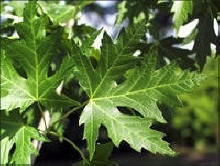
(7/29) When my husband and I bought our house nineteen years ago, it did not have too much in the way of curb appeal. It did, however, have a creek running through the property, and an ancient silver maple shading the house. I was sold.
In the world of horticulture, a silver maple is thought to be a weedy tree. It has no showy display of flowers in the spring, like a dogwood. It does not have outstanding fall color, like a sugar maple. It lacks decorative persistent winter fruits, like a crabapple. Instead, it offers helicopters to clog the gutters and drab fall color.
In nature, silver maples grow in flood plains. They are important for waterways because they grow quickly and hold the soil in place to prevent erosion, keeping sediments from clogging fishing holes. Growing near streams and rivers, they also act as a buffer of protection for fish. Because they absorb nutrients like nitrogen that move easily through water and soil,
they help prevent fish kills in the bay. Silver maples also have great value to wildlife like songbirds, providing a resting place, food, and shelter.
Every spring, when the robins return from their migration, they rest in the shelter of my tree. From there, they launch and fly to the surrounding fields to extract worms. When they are full, they return to my silver maple. This goes on until the guys and gals select their mates and move elsewhere to build their nests.
My silver maple also acts as a cafeteria for hungry birds. In warm months, insect meals are readily available. This morning, a pair of wrens are conversing. One of them finds a caterpillar and lays it down so it can tell the other what it found. They take off. Perhaps they will feast alone and not tell their young. Perhaps they will share. I don’t know. But it is
miraculous to watch.
 My tree offers bird food in winter months too. When insects seek shelter in the cracks of the hard, scaly bark, birds like nuthatches know where to look. They perch upside-down, searching all the nooks and crannies for a protein packed meal.
My tree offers bird food in winter months too. When insects seek shelter in the cracks of the hard, scaly bark, birds like nuthatches know where to look. They perch upside-down, searching all the nooks and crannies for a protein packed meal.
While nuthatches are upside-down playing peek-a-boo, woodpeckers use a different technique. They drill into weak wood to remove insects that are feeding, pupating, or overwintering there. Insects are attracted to weak or dying wood and so are woodpeckers. Dead branches, called snags, are where they make their homes.
Providing camouflage is another important function of a silver maple. Once, when my daughter Liza was three, she told me that there was a frog on the wall of my bedroom. "Sure there is", I thought to myself. Of course, she was right. There was a tree frog on the wall of my bedroom. It stood in stark contrast to the white wall. Assuming it must have blown out of the
tree with a storm, I took it outside to return it to its’ home. I placed the tree frog on the bark and it vanished in front of my eyes.
You won’t find the silver maple featured in Horticulture Magazine article. There are no animals on the editing team. It doesn’t have the showy, ornamental value that we homeowners crave. What is does offer is protection of our waterways, security for our soil, food and habitat for songbirds and other wildlife, and entertainment value- for people like me who appreciate
what it does have to give. I’m not too old to stick a helicopter on my nose.
Read other articles on trees
Read other articles by Susie Hill